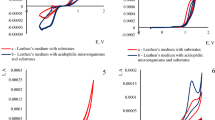Abstract
A hyperbolic equation was fitted to the time dependence of Thiobacillus ferrooxidans adsorption on sulfur. This procedure allowed the determination of an asymptote value which represented a free cell count at equilibrium. The data thus obtained were used to calculate the numbers of adsorbed bacteria without attainment of equilibrium. The maximum number of adsorbed bacteria based on the Langmuir isotherm was 8.3 × 109 per g of sulfur.
Similar content being viewed by others
References
Espejo RT, Romero P (1987) Growth of Thiobacillus ferrooxidans on elemental sulfur. Appl. Environ. Microbiol.: 1907–1912.
González R, Gentina JC, Acevedo F (1999) Attachment behaviour of Thiobacillus ferrooxidans cells to refractory gold concentrate particles. Biotechnol. Lett. 21: 715–718.
Gourdon R, Funtowicz N (1998) Kinetic model of elemental sulfur oxidation by Thiobacillus thiooxidans in batch slurry reactors. Bioprocess Eng. 18: 241–249.
Konishi Y, Takasaka Y, Satoru A (1994) Kinetics of growth and elemental sulfur oxidation in batch culture of Thiobacillus ferrooxidans. Biotechnol. Bioeng. 44: 667–673.
Author information
Authors and Affiliations
Rights and permissions
About this article
Cite this article
Češková, P., Mandl, M. & Hubáčková, J. Kinetic quantitation of sulfur-oxidizing bacteria adsorbed on sulfur. Biotechnology Letters 22, 699–701 (2000). https://doi.org/10.1023/A:1005639804334
Issue Date:
DOI: https://doi.org/10.1023/A:1005639804334




